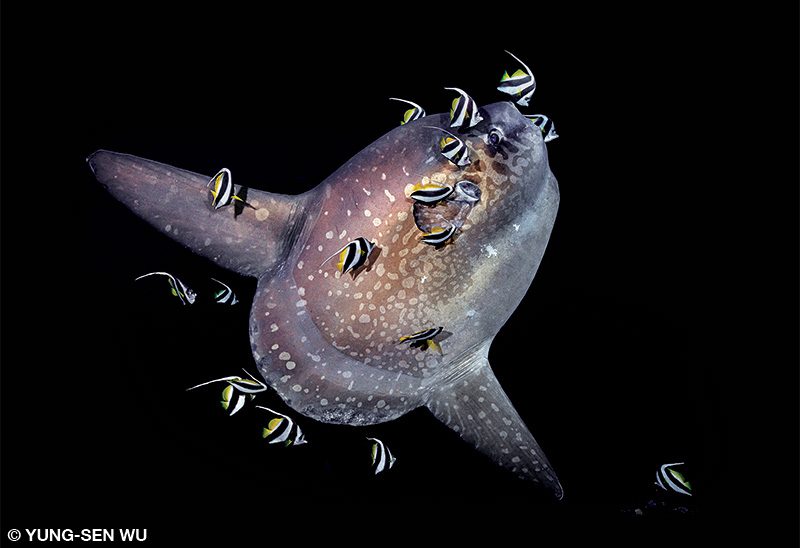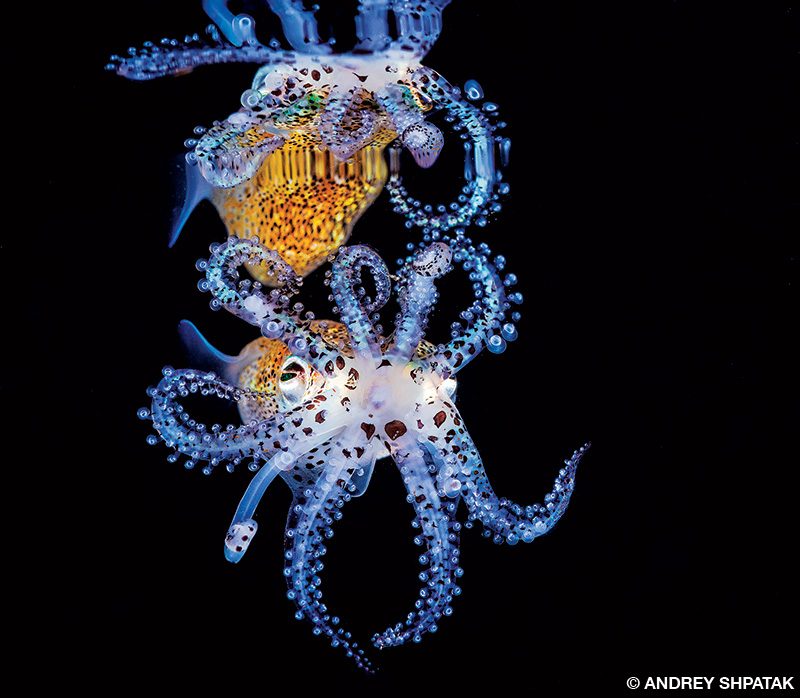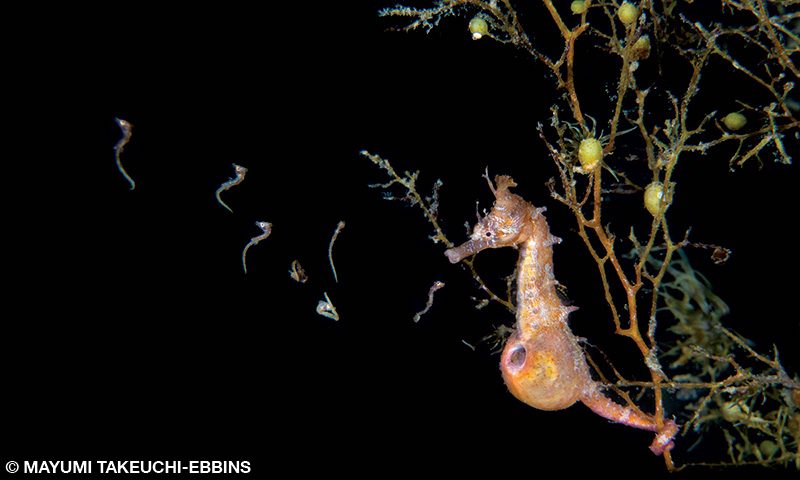Recent social media posts by some of our most esteemed underwater photographers bring to mind the lyrics of an old Bruce Springsteen song: “I had a friend was a big baseball player back in high school. He could throw that speedball by you. Make you look like a fool.” Most of the images these photographers have been posting lately are their “speedballs” from years past, because they aren’t able to take trips and make new photos due to the travel restrictions related to the COVID-19 pandemic.
Their images are the ones that tell the stories of where they went then and the photo opportunities they enjoyed at that time. Maybe a magical encounter or a technical achievement makes these particular photos rise to the top. While we aren’t traveling like we used to, however, we can at least live vicariously through the collective consciousness of our image-makers.
As this year’s Ocean Views photo contest celebrates the 10th anniversary of the collaboration between Alert Diver and the Nature’s Best Photography magazines for the 2020 Nature’s Best Photography International Awards, the collection of entries is replete with speedballs of significance. The quality of the photography is the best we’ve judged yet and coincidentally the most eclectic in subject and location. Viewed in aggregate, the 31,000 images and videos submitted by 2,000 entrants from 67 countries cover a range of destinations including polar, Caribbean, Indo-Pacific and even freshwater habitats.
For the past few years it appears there was no place on the planet too far, too arduous or too obscure to motivate underwater photographers to embark on expeditions. The captions for the 16 winning and highly honored images reveal travel to Japan; Bonaire; Anilao, Philippines; Monterey Bay, California; Raja Ampat, Indonesia; Tenerife, Canary Islands; Antarctica; Tulum, Mexico; Baja California, Mexico; Iceland; Norway; Romblon, Philippines; and Greenland. Imagine the time these photographers spent on airplanes and boats and underwater to take 31,000 images good enough to submit to a photo competition of this high caliber.
These images make us long for the time when we can once again travel the world in pursuit of our underwater passions. Let’s hope that 2021 will be that time when we can visit new places or old favorites and create our own new batch of speedballs.
There’s a Bruce Springsteen lyric relevant for that too. “Yeah, just sitting back trying to recapture a little of the glory of, well time slips away and leaves you with nothing mister but boring stories of glory days.” When dive travel is safe again, we need to be on those boats making giant strides into new adventures and taking new photos for Ocean Views 2021. Our glory days are yet to come.
— Stephen Frink

WINNER
Ocean Sunfish
Nusa Lembongan, Indonesia
By Yung-sen Wu
One of the world’s heaviest bony fish, the ocean sunfish (Mola mola) has developed some unique symbiotic relationships with a variety of species, from seagulls to wrasses. The sunfish will signal when they need a cleaning of their scaleless body, which is covered with thick, elastic skin. Their size and slow movements allow them to sometimes be a habitat for more than 40 species on a single fish. While sunfish often hunt at depths between 600 and 2,000 feet, I photographed this one at 121 feet.
Sony a7R III, FE 12-24mm f/4 G lens at 24mm, 1/100 sec, f/8, ISO 640, Seacam Seaflash 150D strobes (2), Seacam housing; FB @acewuuwp

Bobtail Squid
Anilao, Philippines
By Andrey Shpatak
One of the simplest and most beloved dive sites in Anilao is near Anilao Pier, where the depths range from 6 to 16 feet (2 to 5 meters), and you can wander for hours in search of interesting animals. On the final night dive of a blackwater trip, I started taking photos of this small squid at a depth of 6 feet (2 meters). As it began to rise to the surface of the water, I had only a moment to take this shot before the squid changed its position and depth.
Nikon D500, 60mm lens, 1/100 sec, f/20, ISO 400, Inon Z-220 strobes (2), Sea and Sea housing; IG @andrey_shpatak

Japanese Seahorse Hatchlings
Minamata Bay, Kumamoto Prefecture, Japan
By Mayumi Takeuchi-Ebbins
Japanese seahorses mate between April and July, and each pair will pass eggs and hatch babies four to five times each season. For weeks I woke up at midnight and dived from 1 a.m. until 7 a.m. in shallow water at about 13 to 23 feet. On one dive I waited in front of the seahorse for the hatching for four hours. You have to be crazy about seahorses to do that. It was an incredible moment when I saw little baby seahorses hatch from the father’s pouch.
Nikon D500, 60mm f/2.8 macro lens, 1/400 sec, f/16, ISO 320, Inon Z-240 strobes (2), Light and Motion Sola Photo 1200 target light, Nauticam housing; IG @squirri007_diving

Humpback Whale
Monterey Bay, California, USA
By Chase Dekker
Late summer is one of the best times to watch humpback whales in Monterey Bay because they tend to be most active then. One evening as I was guiding a whale watch, about 10 to 20 humpbacks started breaching around us. For almost three hours whales were flying out of the sea and occasionally landing close enough to spray us with their splashes. Near the end of the evening a large adult whale began to breach next to the boat, launching out of the water like a rocket. It breached like that several times during the last light of the day as it headed for a nearby pod of feeding whales.
Canon EOS 5D Mark IV, EF 300mm f/2.8L IS II UM lens, 1/2000 sec, f/5.6, ISO 1600, handheld; chasedekker.com

Iceberg
Diamond Beach, Jökulsárlón, Iceland
By Ilan Shacham
The Jökulsárlón glacier lagoon has an outlet to the North Atlantic Ocean, where small icebergs float into the ocean. Waves then sweep them back onto the black volcanic beach, creating a wonderful sight. I arrived at the beach before sunrise, hoping to photograph the sunshine through the clear ice. When I saw this beautiful iceberg with a hole, I knew I wanted to use it to frame the rising sun. This ice chunk was only about a foot across, so I lay down on the beach in front of it and framed the sun in the hole, capturing its gorgeous light illuminating the ice from within.
Nikon D810; 24-70 f/2.8 lens at 44mm; 1/800 sec, 1/200 sec, 1/3200 sec (HDR); f/11; ISO 640; handheld; IlanShacham.com

Fluorescent Coral with Goby
Bari Reef, Bonaire, Dutch Antilles
By Peter de Maagt
Coral fluorescence offers a potential resource for scientists and conservationists. Some researchers believe this fluorescence could protect against damaging sunlight or serve as a biological chemical defense, generated during times of stress. Researchers are now using fluorescence as an effective tool for gauging the overall health of coral gardens. Fluorescence diving allows you to see a familiar reef in a new light. The pieces of coral that were dull and gray during the daytime could be glowing from within at night. I captured this transparent goby backlit by the fluorescent glow of the coral.
Nikon D500, 105mm f/2.8 macro lens, 1/200 sec, f/14, ISO 400, Sea and Sea YS-250 strobes (2), Sea and Sea housing; FB @peter.demaagt, IG @pdemaagt

Sweetlips
Misool, Raja Ampat, Indonesia
By Eduardo Acevedo
Underwater photographers can usually find sea life to collaborate with at depths below 100 feet. This time I had the help of a huge ball of crystal fish and incredible colors of the hard and soft corals as I photographed these sweetlips in Raja Ampat.
Canon 5D Mark IV, EF 15mm f/2.8 fisheye lens, 1/40 sec, f/8, ISO 200, Inon Z-240 strobes (2), Seacam housing

Sand Tiger Shark
Morehead City, North Carolina, USA
By Lureen Ferretti
The “Graveyard of the Atlantic” along the North Carolina coast offers the best wreck and shark encounters in the U.S. Sand tiger sharks, also known as spotted ragged-tooth sharks or gray nurse sharks, prefer warm coastal waters and shallow bays in most areas of the world except for the eastern Pacific.
Sand tiger sharks may look menacing with their gnarly teeth protruding erratically from their mouth, but they’re actually quite docile. While diving the Aeolus wreck, I found a sand tiger shark that didn’t mind my presence as it continued to swim slowly in a somewhat lethargic state. A cloud of little fish surrounded it, staying close by for protection to prevent the schools of tunas and jacks from swooping down to eat them.
Canon EOS 70D, Tokina 10-17mm f/3.5-4.5 fisheye lens at 10mm, 1/160 sec, f/11, ISO 320, Inon Z-240 strobes (2), Nauticam housing; DeepWaterPics.com

Orcas
Skjervøy, Troms, Norway
By Jens Wikström
Every winter hundreds or sometimes thousands of orcas travel to the fjords near Skjervøy, Norway, to feed on herring. These orcas were curious, approaching our Zodiac boat and spyhopping to get a closer look. I took this photo just as the sun had gone down behind the mountains and Northern Norway’s ethereal winter light settled over the landscape. Orcas have strong family groups and extremely social behaviors. As a guide, I have observed them in the wild expressing camaraderie, teamwork, curiosity, ingenuity and joy.
Nikon D850, Nikkor 70-200mm f/2.8G ED VR II lens at 190mm, 1/1250 sec, f/2.8, ISO 800, handheld; wikstromphotography.com

Iceberg and Schooner
Scoresby Sound, East Greenland
By Jim Guerard
While cruising on a 144-foot sailing schooner through Scoresby Sound in Greenland, we came upon a massive iceberg with three towers that was floating in the channel. I used my drone to provide a three-dimensional view of this amazing ice mass. Flying the drone out away from the boat and shooting the image looking back to include the boat as it was coming upon the edge of the iceberg provided perspective on size as well as the danger lurking just beneath the surface. It was a sobering reminder of how quickly and irrecoverably our world is changing.
DJI Mavic 2 Pro drone with factory-installed Hasselblad L1D-20c camera at 10.26mm, 1/1600 sec, f/4, ISO 100; jimguerard.smugmug.com

Striped Marlin
Magdalena Bay, Baja California, Mexico
By Greg Lecoeur
In November the migration of striped marlin (Kajikia audax), which are apex predators, coincides with the formation of bait balls teeming with thousands of sardines off Baja California. It’s an opportunity to witness rare and spectacular predation scenes from the animal kingdom as other predators such as sea lions and seabirds come to feast. The underwater view is splendid as striped marlins and sea lions compete over a bait ball. One by one they launch dazzling attacks that leave their prey no chance of survival.
Nikon D500, Tokina AT-X 107 DX 10-17mm f/3.5-4.5 fisheye lens at 17mm, 1/250 sec, f/9, ISO 400, Ikelite DS161 strobes (2), Nauticam housing; greglecoeur.com

Japanese Seahorses
Minamata Bay, Kumamoto Prefecture, Japan
By Mayumi Takeuchi-Ebbins
Seahorses engage in a courtship dance, holding each other’s tails or hanging onto the same seagrass strand and then whirling together for many hours. The female deposits her eggs into the male’s pouch, and the male contributes additional nutrients until the eggs hatch in his pouch and then releases the fry to be on their own.
Nikon D500, 60mm f/2.8 macro lens, 1/200 sec, f/13, ISO 200, Inon Z-240 strobes (2), Light and Motion Sola Photo 1200 target light, Nauticam housing; IG @squirri007_diving

Diamond Squid
Anilao, Philippines
By Yatwai So
During a blackwater dive near Anilao, I saw this diamond squid at a depth of about 50 feet. I took a series of photos showing the squid changing colors from its original light purple to reddish-orange. This photo shows the complete change of its body color to orange.
Canon EOS 5DS R, EF 100mm f/2.8L Macro IS USM lens, 1/200 sec, f/18, ISO 200, Ikelite DS161 strobes (2), Scubalamp RD95 focus light, Sea and Sea housing; FB @yatwai.so, IG @yatwaiso

Goby on Sea Pen
Anilao, Philippines
By Yatwai So
The sea pen is common on the Anilao Sea’s sandy bottom, with gobies or small crabs hiding inside for protection. I used a pair of orange lights on the sandy bottom to illuminate this sea pen, and I used a narrow single snoot flash to light the goby and get rid of the orange colorcast. I tried to shoot at eye level and at many angles. The frontal shot with around 30 degrees elevation and a shallow depth of field can make the sea pen look like a luxury red carpet.
Canon EOS 5DS R, EF 100mm f/2.8L Macro IS USM lens, 1/100 sec, f/7.1, ISO 100, Ikelite DS161 strobe with LSD snoot, macrophotography torches with orange filters (2), Sea and Sea housing; FB @yatwai.so, IG @yatwaiso

Leopard Seal and Gentoo Penguin
Cuverville Island, Antarctica
By Eduardo del Álamo
This gentoo penguin was resting on a fragment of broken ice as I watched the leopard seal swim back and forth. Moments later the seal flew out of the water with its mouth open, and the penguin fled for its life. Leopard seals are formidable predators with slender bodies that are built for speed and wide jaws that bear long canine teeth. They hunt almost anything, changing their diet in response to availability and the time of year. In addition to penguins, they like to eat krill, fish, squid and the pups of other seal species.
Canon EOS 7D Mark II, EF 100-400mm f/4.5-5.6L IS II USM lens at 110mm, 1/2500 sec, f/10, ISO 1000, handheld; eduardodelalamo.com

Dos Pisos
Tulum, Mexico
By Ellen Sophie Cuylaerts
When I was a fairly new cave diver, cave explorer Robbie Schmittner took me to Dos Pisos to show me some of the beauty he has explored. I was in awe when his lights revealed the most beautiful passages and chambers. As he approached another chamber, my mind started to envision an image. I quickly adjusted my camera’s settings for this dark environment and waited for the moment when his silhouette stood out against the reflection of lights bouncing off the walls of the cave and the water’s surface.
Nikon D800, 16mm f/2.8D lens, 1/80 sec, f/5.6, ISO 3200, Subal housing; ellencuylaerts.com

Isopod on Red Bigeye
Canary Islands, Spain
By Eduardo Acevedo
Red bigeyes sometimes come in contact with aggressive isopods (family Cymothoidae) and have difficulty removing them. This isopod was on the front of the fish’s head between its eyes, feeding on its mucous membranes, skin and blood. The parasite, which was about 0.75 inches (2 cm) long, will probably lay eggs on that area and then move around the fish’s body looking for new places for feeding.
Canon EOS 5D Mark II, 100mm lens, 1/200 sec, f/32, ISO 100, Inon Z-240 strobes (2), Seacam housing
Explore More
See more amazing image submissions from talented photographers in these two bonus photo galleries.
© Alert Diver — Q3/Q4 2020